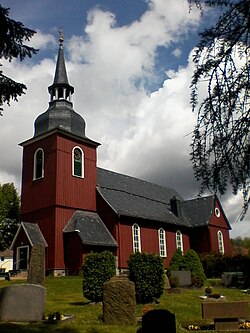Hohegeiß
| Hohegeiß | ||
|---|---|---|
| Stadtteil of Braunlage | ||

Parish church
|
||
|
||
| Coordinates: 51°39′50″N 10°40′08″E / 51.66389°N 10.66889°ECoordinates: 51°39′50″N 10°40′08″E / 51.66389°N 10.66889°E | ||
| Country | Germany | |
| State | Lower Saxony | |
| District | Goslar | |
| Town | Braunlage | |
| Elevation | 600 m (2,000 ft) | |
| Population | ||
| • Total | 1,000 | |
| Time zone | CET/CEST (UTC+1/+2) | |
| Postal codes | 38700 | |
| Dialling codes | 05583 | |
Hohegeiss (German: Hohegeiß) is a health resort and winter sports village in the Harz mountains range. Since 1 July 1972 Hohegeiss has been part of the town of Braunlage, in the district of Goslar in Lower Saxony, Germany.
Hohegeiss lies on the Bundesstrasse 4 highway running across the Harz range, between Braunlage proper and Benneckenstein, at a height of between 570 and 642 m above NN. Neighbouring villages are Zorge to the south, Rothesütte (part of Ellrich) to the southeast, Benneckenstein to the east, and Sorge to the north. The village has about 1,000 inhabitants.
The former inner German border (today the state border with Saxony-Anhalt) runs immediately on the northeastern edge of the settlement. On this border, about 3.3 km to the southeast of the village, is the tripoint for the three states of Lower Saxony, Saxony-Anhalt and Thuringia, which is marked by the Drei-Länder-Stein.
The mountain village is surrounded by the Harz Nature Park. Near the village is the Dicke Tannen natural monument with the largest spruce trees in Northern Germany.
The village name comes from Hogeyz, the name of a wooded region that is documented as early as in 1268. A first chapel was erected in the woods in 1444, a settlement was mentioned in 1528. With the former estates of Walkenried Abbey, Hohegeiss fell to the Dukes of Brunswick-Lüneburg and was administrated within the former County of Blankenburg as a southeastern exclave of the Principality of Wolfenbüttel. The present-day Protestant church was consecrated in 1704. The former mining area became a popular tourist destination from the late 19th century onwards.
...
Wikipedia


